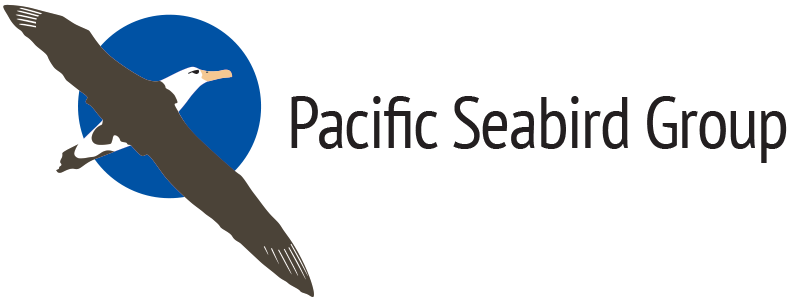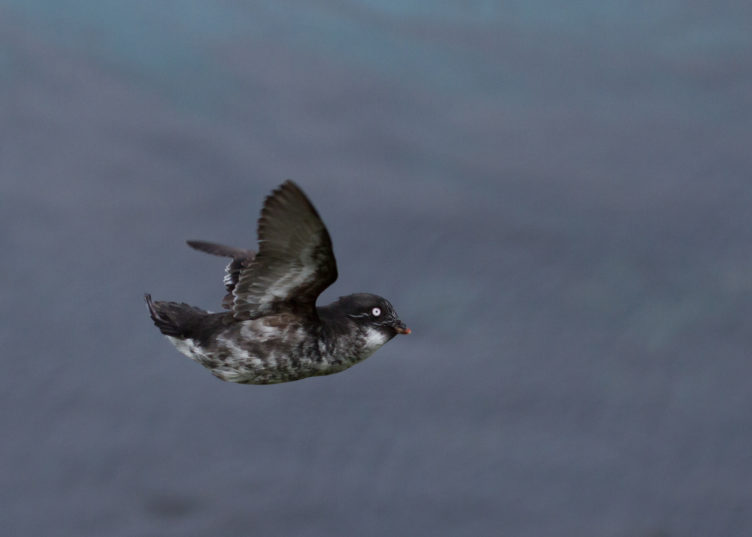Pearson et al. (2024)
Author Information
Scott Pearson: Washington Department of Fish and Wildlife
Eric Wagner: Center for Ecosystem Sentinels
Thomas Good: NOAA
Peter Hodum: University of Puget Sound & Oikonos
Sue Thomas: Washington Maritime National Wildlife Refuge
Marbled Murrelet, Tufted Puffin, and Rhinoceros Auklet Monitoring and Research
Scott Pearson (Washington Department of Fish and Wildlife), Tom Good (National Oceanic and Atmospheric Administration-Northwest Fisheries Science Center), Peter Hodum (University of Puget Sound and Oikonos), Sue Thomas (Washington Maritime National Wildlife Refuge Complex), and Eric Wagner (University of Washington) continued their long-term study of reproductive success patterns of Rhinoceros Auklets (Cerorhinca monocerata) on Protection (17th year) and Destruction (14th year) islands, Washington, USA.
Burrow occupancy and fledging success were comparable to long-term averages on both islands. Dietary studies were conducted during the early and late chick-rearing stages on both islands, with diet composition similar to previous years. The chick provisioning diet on Protection Island continues to be dominated by Pacific sand lance and to a lesser extent Pacific herring, while the Destruction Island diet is characterized by a much wider variety of forage fish species.
In a project led by Sue Thomas, autonomous recording units (ARUs) were deployed at Alexander and Carrol islands to characterize breeding phenology, species composition (six species), and vocal activity over time and between colonies. It is hoped this work will develop into a long-term monitoring effort.
In addition to the Rhinoceros Auklet and ARU studies, they continued their conservation research program on Tufted Puffins (Fratercula cirrhata), focusing on mapping active breeding burrows on Smith and Destruction islands. They also monitored puffin breeding activity and foraging ecology on Destruction Island, including nestling diet characterization using photographic ID of bill loads. The team also continued a complementary study of diet using a genetic barcoding approach on fecal samples collected at puffin burrows. Sue Thomas led boat-based Tufted Puffin burrow count and bill load surveys off Smith Island within the San Juan Islands NWR in August. The objectives of these surveys were to estimate the minimum population of provisioning puffins and analysis of chick diets prior to fledging. Finally, Scott Pearson also led a pilot Tufted Puffin social attraction project on Protection Island that included both nest boxes and decoys and cameras were used to assess success.
Scott Pearson, Monique Lance, Kelly Beach, Sarah Tanedo, and Kristin Sasksa (Washington Department of Fish and Wildlife) continued their 24-year at-sea monitoring of Marbled Murrelets (Brachyramphus marmoratus) along Washington’s coastal waters as part of the Northwest Forest Plan Effectiveness Monitoring Team and funded by USFWS. They also continued their 12th year of non-breeding U.S. Navy funded surveys during the non-breeding season in Puget Sound. Lance and Pearson (along with numerous partners) initiated a U.S. Navy funded project examining murrelet diet. This study compares Marbled Murrelet diet information (fecal DNA) with information about available prey derived from hydroacoustics, mid-water trawls, and eDNA.






